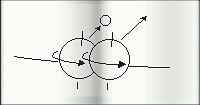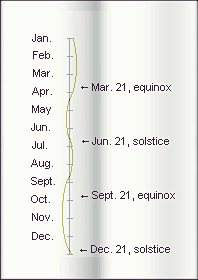
| CONTENT - More about the solstices and equinoxes, with a passage about the Equation of Time |
The most common understanding of how the seasons work (see "Seasons") brings to this simple idea that the length of days and nights are equal at the moment of the equinoxes, and that days are steadily moving to shortest when the winter solstice approaches as nights are for the summer one. This is mostly true for the most usual definitions. Some refinements are to be introduced however as some considerations interferes and brings that the day is actually longer than night at the equinoxes, and that the way the length of day and night varies around the solstices is not proportional
| Day is Actually Longer than Night at the Equinoxes | The Variation of Days and Nights' Length at the Solstices is not Proportional |
The time of sunset and sunrise, as computed for the almanachs, is the moment where the leading (upper) or trailing (inferior) edge of Sun is crossing the horizon upwards or downwards respectively, plus the value of the atmospheric diffraction (an optical modification of the light's path, which makes the Sun visible before or after it's actually risen or set). This value is 34", as the semi-diameter of Sun's disk as used by almanachs is 16". Hence the actual duration of sunlight a given day is larger than the duration given by the almanachs. The additional duration is what it takes to the Sun to move of 100" ((34" + 16") x 2) in altitude each day
The first consequence of that, for our purpose, is that the actual duration of the day -compared to the almanach time- is longer than the actual duration of night for any given day. In other terms, at any date, as the center of the solar disk is geometrically below or above the horizon, the Sun is actually seen longer above the horizon, as it's actually seen before the almanach time of sunrise and after the almanach time of sunset. This is true for the equinoxes' dates. The amount of the difference varies according to the latitude (North or South) of the observer. The higher the latitude, the smaller the angle of the ecliptic to the horizon at sunrise or sunset, hence the longest the time it takes to the Sun to appear or disappear
At the equinoxes dates, this translates into that the length of days and nights is theoretically equal but actually different. At the equinoxes' dates, North or South, the day is actually longer than night. It's longer by about 8 minutes at a latitude of 25° North or South, 11 minutes at mid-northern or mid-southern latitudes, and up to about 22 minutes at a latitude of 60°! Even at the equator, the difference is of several minutes. This means too that, in the northern hemisphere, day's length is actually equal to night's before the vernal equinox (which usually is about March 21) and after the autumn equinox (about September 21). And the reverse South. At a latitude of 5°N, for example, the dates of equal day and night are about February 25 and October 15. In mid-northern latitudes, the days are equal to nights on about March 17 and September 26
Let's have a look now at the solstices! It's a definite fact that, on the day of the winter solstice, an observer will see sunlight during the year's least amount of time, and that, on the day of the summer solstice, he will see it during the largest. This is true for the northern or the southern hemispheres. An advanced remark however is that the way the time of sunrise and sunset are evolving before and after the solstices dates is not proportional. Should we take the winter solstice, the proportional way should be that the sunrise should occur later and later each day until the solstice's date as the sunset earlier and earlier. And the opposite after the solstice. This is not true, due to a combined effet of the position of the Earth on its orbit and of what is called the "Equation of time"
 | a solar day. An additional rotation is needed to get the Sun at the same apparent location |
The Equation of Time is a concept working with the concept of "solar day". A solar day is the length of time elapsing between two passages of the Sun at the observer's meridian, that is overhead. In one day however the Earth moves on its orbit. Hence each day the observer is seeing the Sun slightly more East, that is late somehow. Each day, it needs an additional rotation of 4 minutes (1°) to see the Sun back at the observer's meridian. This is one point. The 4-minute shift is not steady along the year. This is due to two factors. The Earth's orbit, on one hand, is an ellipse. At one point of it, the Earth is speeding (when it's nearest to the Sun, in January), at another point, it's slowing (when it's farthest from the Sun, in July). The difference of perspective between the ecliptic and the celestial equator, on the other hand, is making that, at the solstices, the ecliptic (the path of the Sun) is seen running parallel to the celestial equator. Hence the Sun appears to move more slowly against the background sky (at the equinoxes, at the opposite, the ecliptic is at an angle with the celestial equator, hence the Sun is seen moving more swiftly). That's the second point
 | the Equation of Time along the year |
It's these two causes which are yielding the Equation of Time. Due to these combined differences of motion (of the Earth around the Sun, of the Sun in our sky), the daily 4-minute shift is not steady along the year. The Sun will be late, relative to noon at your watch, by a different amount of time and there are some parts of the year when it will even change into early. The "Equation of Time" is the actual daily shift between the solar day and the actual noon. Or the Equation of time may be termed too: the difference, for a given day, between noon at your watch and the time at which the Sun passes just at your meridian. The Sun is late relative to your noon from about the last week of December to mid-April and from mid-June to the last week of August, as it's early from mid-April to mid-June and from the last week of August to the last week of December. The amount of late or early varies from 0 to up to 15 to 16 minutes (for the periods last week of December-mid-April and last week of August-last week of December) and from 0 to 4 to 6 mn only (for the periods mid-June-last week of August and mid-April-mid-June)
So! What does that means in terms of the variation of day's and night's length before and after the solstices? The seasons' phenomenon -that is where the Earth is on its orbit- is remaining the main factor to the time at which the Sun rises and sets each day. As we are moving towards the solstice, the Sun is rising later and setting earlier each day. The motion, then, starts at the opposite, with the Sun rising earlier and setting later each day. The Equation of Time is adding however. When the Sun is late at noon, this means that it's rising later, and setting later too. Hence the proportional, steady variation, which should occur due to the sole seasons' phenomenon, is perturbed. In the northern hemisphere, as far as the winter solstice, about December 21, is concerned, the Equation of Time is increasing the sunset to later until the solstice, as it's braking the move of sunset to earlier. It's the opposite after the solstice. The sunrise move to earlier is braked as the sunset is increased in its move to later. Earliest sunset occurs on December 8th, as latest sunrise on January 5th. The same changes are affecting at the moment of the summer solstice, but not as extreme. At a latitude of 40° N, the earliest sunrise occurs about June 14 as the latest sunset is about June 28. All in all, this makes that we are granted with a larger period of "dark days" in winter and of "bright days" in summer. On the other hand, let's note too that it's the Equation of Time which accounts for the famed "analemna", the position of the Sun, each day at the same time, having the form of an "8", which can be photographed (CAUTION! OBSERVING THE SUN IS DANGEROUS AND MAY CAUSE IRREVERSIBLE EYE DAMAGE, UP TO BLINDNESS; see our special page about the dangers of observing the Sun) or which is used for sundials' construction
Website Manager: G. Guichard, site 'Amateur Astronomy,' http://stars5.6te.net. Page Editor: G. Guichard. last edited: 12/28/2010. contact us at ggwebsites@outlook.com